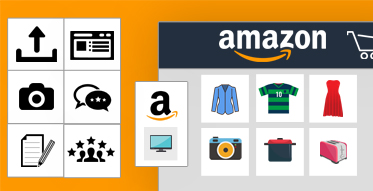
Welcome to part 2 of our Selling Home Decor Items On Amazon series.
We are going to look at how Bullet Points, Product Ratings, and Product Reviews can help you sell home decor items on Amazon (and be successful at it!)
In the first part, we learnt how Product Images, Product Title, and Product Description can help you in disseminating accurate and engaging information to your customers, and more importantly, how you can get these three elements right in the first place.
So, if you haven’t checked out the first part yet, be sure to do it before moving on.
Getting started with Part 2
Bullet Points / Product Features
You ought to tell the customers if your products can address their pain points, or prove to be beneficial for them in one way or the other. Keep in mind that merely mentioning the features of your home decor items won’t do the trick, and you’d have to tell the customers what’s in it for them. Here’s an example:
Feature-centric approach: The bottoms of our candle holders are lined with high-quality velvet
Benefit-centric approach: The velvet bottoms of our candle holders help avoid table scratches
Cheat Sheet:
- Keep the keyword usage to a bare minimum. If you did miss out on some of the important keywords, the ones that you couldn’t include in the title, by all means, go ahead and place them here. Even the LSIs (Latent Semantic Indexing keywords) would do. So, if you are to sell, say, a candle holder, your options could possibly include:

(Source: LSIGraph)
But don’t go overboard. Any Amazon product listing optimization services company worth its salt would tell you that stuffing is a bad idea. And so is creating a jumbled-up bullet point that makes no sense whatsoever. If the pointer is incomprehensible, it won’t do you any good.
- Don’t write one for the sake of it. “Free returns” or “30-day return policy” are things that your customers are already aware of, unless of course they are first-timers and are yet to shop off Amazon. And even if it were the case, let Amazon tell them about the return policy, while you pass on information related to your product.
- Play by the rules:
- Use sentence case, or in other words, start each of your pointers with a capital letter.
- And let go of unnecessary punctuation. It could be one of the biggest distractors.
- Next up, stick to the character limit. Large blocks of text would do you more harm than good. Anything between 10 to 250 characters per bullet point should suffice.
- Last but not least, be sure to include only 5 bullet points in your Amazon listing. If you feel the underlying need to share a little more information, okay, fine, go up to 6, but that’s just about it. Anything beyond 6 is likely to go unnoticed, and would deprive you of the opportunity of making Amazon SEO work in your favor.
- Here’s what your bullet points should ideally look like:
- Bullet 1: A gist, or a synopsis, one that clears the air
- Bullet 2: Materials that may have been used to make the product. And would the customers require to assemble your products? If yes, let them know.
- Bullet 3: Highlight the most important features of your products, but as already discussed, weave them together in such a way that they make your products look beneficial.
- Bullet 4: Anything that’s left, including those trivial features that may or may not play an important role can be incorporated here.
- Bullet 5: Are you offering some accessories as well? Because if you are, now’s when you tell it to your customers, and take them by surprise, giving them yet another reason to buy whatever it is that you are selling.
Mind Dump
Write down everything you know about your products – features, specifications, just about everything. Dump it all on paper. Once you have the information handy, you can easily come up with pointers that work wonders for your Amazon listing.
Product Reviews
Reviews are important, period. And guess what, reviews on Amazon or the lack thereof could very well determine whether or not you are able to successfully sell on other channels. That’s because whether you have a Shopify store or an eBay one, chances are your customers (well, the prospective ones) would first search for your products on Amazon, check out the reviews, and find out all there’s to know, before making a purchase. In short, you need as many reviews as possible, if you are to make the most of the eCommerce bubble, Amazon or otherwise.
Cheat Sheet:
- Don’t even think about incentivized reviews. Amazon has banned them for good. So, if you have been meaning to offer free or discounted products or take to review sites, better drop the idea.
- You may send up follow-up emails, but make no mistake, sending mails with promotional content or links to third-party websites is a big no-no. Also, avoid email spamming at any cost. 2-3 emails should do. Don’t flood their inbox. Rather, give them an outlet of sorts, wherein they can open up and share their honest opinion with you, even if they don’t like the product. This could help nip an impending negative review in the bud.
- Product inserts can also come in handy. Say, add a card or a leaflet to your Amazon package before sending it to the customers, but make it a point to highlight the benefits of your home decor items. Vie for a deja vu effect, if you will, but it’s important that your customers are reminded of why they bought your products in the first place. Alternatively, you could send across a customer satisfaction survey of sorts. Either way, don’t offer a discount code and simultaneously ask for a product review, encourage a 5-star rating, or worse, redirect customers to a website other than Amazon.

- Amazon has its own review programs that you can leverage.
On that note, let’s discuss the review programs in detail for a better understanding:
Early Reviewer Program
This could be your gateway to getting those first few reviews for your product, fetching which could otherwise be your worst nightmare. And that’s because unless you have those reviews, you’d have a hard time selling, and vice versa. It’s a vicious circle. So, this program could save the day.
Cheat Sheet:
- The program encourages customers who have already bought the products to share their authentic experiences. Now, you could get a 1-star review or a 5-star one; just be prepared.
- And yes, do keep in mind that you or your friends and family can’t participate in the program.
- Also, while you can select the products for this program, what you cannot do is zeroing in on the customers who’ll be asked to review those products. And it goes without saying that trying to communicate with the customers and/or influencing their reviews in any way is a prohibited!
- As a seller, you’ll have to pay $60 for each eligible SKU. Meaning, if you were to enrol 50 of your SKUs in the program, the Early Reviewer Program would cost you $3,000, which could be a bit on the expensive side. So, it’s advisable that you jump on the bandwagon with only 10 SKUs to begin with.
- But then, money alone won’t get you in. You have to get your brand registered with Amazon Brand Registry, and only then you can think about using this program to your benefit. And registration may make you eligible, but you might not be able to enrol if your products already have a decent share of reviews.
- An orange badge would help you identify all such reviews.
Amazon Vine
Well this is another of Amazon’s review programs that you can participate in, but again, you cannot influence, modify, or edit the reviews. What you can do however is to enrol pre-release products for Vine Voices to review. Now, this could give you the first-mover advantage as your products will be reviewed prior to launch.
Cheat Sheet:
- As of now, Amazon Vine is only available to vendors, as in businesses selling through Amazon Vendor Central.
- You cannot contact the reviewers and/or Vine Voices. All you need to do is to submit your products to Amazon, and then they’ll distribute it further. You also have no say or influence over who reviews your products.
- Only the most trusted reviewers make it to the Vine, and once they are in, they are provided with free products by Amazon, which, as mentioned earlier, need to be submitted to the program by you, the vendor. Since customers are more likely to trust these reviews an/or or independent opinions, you can get the upper hand, if your products are reviewed by the Vine members.
- A green stripe distinguishes every Vine review from an ordinary (or extraordinary, every customer is important, and so is every review, right?) one.
Product Ratings
Reviews, especially the negative ones, can take a toll on your ratings. The two are correlated. So, the more reviews you have, the higher your ratings would be. Let’s take a look at two of the top-rated home decor products, and see what sets them apart. Maybe you can take a cue:
The first one, a set of 3 fake flowers and grass in pots, has a rating of 4.8, with close to 90% of the reviewers leaving a 5-star rating. This right here is what you should aim for. And once you make the cut, try and do better, and don’t settle for 4.8 – now, that’s a good score, no doubt, but there’s room for improvement, there always is.

The second product, a set of candle holders, has also secured a decent enough rating, grabbing 4.6 out of 5 stars. See if you can catch up. You ought to, right?

Coming to your home decor items, well, if the rating stands somewhere between 4 to 5 stars, you are quite there, but if it is not, here’s what you can do:
- Go through each of your negative reviews, and try and identify the pattern. What is the most common concern of all your customers? Which of their pain points have you not been able to address so far? And if there’s one, can you do something about it? Not to mention, if there’s a possible resolution, implement it right away.
- As mentioned earlier, reach out to your customers via email. If they are experiencing buyer’s remorse or are not happy with your product due to any reason, try and resolve the matter, before they take to Amazon and leave a negative review, and inadvertently affect the overall rating of your product.
Final Words
That’s pretty much what an Amazon listing comprises, title, images, description, bullet points, reviews, and ratings. So, when you get down to optimizing your Amazon listings, make sure you work on every element, because these are all equally important, and could be the determining factors for your Amazon store’s success. And if it seems a little too much to handle, well, we are here to your rescue. Write to us at info@data4amazon.com, and we’ll make sure that once we are done optimizing your listings, your sales begin to go through the roof. Are you game? Because we are!
TL;DR (Home Decor Items Selling Tips)
- Make sure your bullet points highlight the benefits of your products, and are not those “blow your own trumpet” pointers that the customers don’t give two hoots about.
- You need to load up on product reviews, but don’t try and “buy” them by incentivizing your customers or resorting to unacceptable measures.
- Ratings would improve once the reviews start pouring in. Till then, figure out what’s wrong with your products, and make amends.



